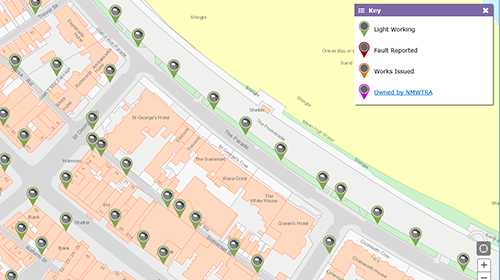Through creativity and innovative use of accurate geospatial data, Conwy has managed to transform and modernise their asset management system to work for them.
Introduction
"If we don't hold a robust inventory of what we are responsible for managing, how can we manage it effectively?"

Asset management principles are vital to the work carried out by Conwy Borough Council, with their local assets covering an expanse of different areas including:
- Highway Drainage
- Highway Assets
- Bridges
- Coastal Assets
- Trees
- Public Rights of Way
as well as various non-physical assets such as:
- Work Records
- Adopted Highway Extents
- Highway Adoption Queries
It is therefore paramount that Conwy maintain a robust asset management system to run and monitor their local assets effectively. Efficient asset management requires both accurate geospatial information and technological implementation to maximise service delivery, therefore the Local Street Gazetteer (LSG) is central to Conwy's Asset Management System and Highways Operations. All local assets are connected to the LSG and linked through their Unique Street Reference Numbers (USRN), providing accurate, current information and helping public services to run more efficiently.
A key example of Conwy implementing successful asset management to maintain their public services is their Street Lighting System. Conwy's Street Lighting System had previously been experiencing some major challenges, which, after updating their asset management system and engaging in new technology they were able to tackle effectively.
They also decided to introduce a Customer Portal into their system, for customers to report and record faults using a user-friendly web interface and is accessible online via PC, mobile or tablet. The Portal can be accessed 24 hours a day, allowing the public to report faults at their convenience and with immediate effect. The public can select online locations of specific faulty street lights, meaning that accurate information is recorded instantly. They are also able to view the current status of a Streetlamp and see whether a fault has already been reported online.
"the quicker we can locate, the quicker we can investigate and resolve the issue."
Challenges
Conwy were facing major challenges to their asset management system that were creating problems for service delivery and operations.
Their Street Lighting system was not linked to an accredited BS 7666 Gazetteer, meaning that data was not referenced or defined to a consistent LSG dataset of USRNs. Working from an inventory of more than 20,000 units with incomplete and inaccurate locations meant that it was difficult for faults and service requests to be recorded and identified in the first instance, impacting both the general public and the internal work force.
There was also no public reporting interface or mobile technology implemented, meaning that reports and faults were reported manually, via a paper works ticket or verbal instruction, creating a slow and inefficient process. There were also no efficient means of updating customers, or a reporting mechanism to monitor and track the progress of reports and faults.
In addition, electricians were reliant on narrative descriptions of fault locations provided over email or phone, leading to frequent miscommunication of incorrect information or location.
Solution
Expand Upon Asset Management System
In 2007, Conwy decided to expand the use of their asset management system, utilising the Asset Register and Inspection modules for Highway Maintenance and Bridges and Structures. In 2013, a decision was then made to incorporate the Street Lighting System functions into their asset management system-a process that was being utilised already in other areas of Highway Maintenance.

The existing Street Lighting Inventory data was imported into their asset management system and a spatial analysis was carried out. This enabled Conwy to allocate each asset to the nearest Street and USRN in the LSG, however, due to the poor quality of the street lighting data and inventory, a large data cleansing project was undertaken. Assets were also checked and reviewed, ensuring that every street light location was referenced to the correct USRN.
Implement Mobile Technology
Mobile technology was introduced in the form of tablets, enabling all jobs, inspections and service requests to be recorded and completed out in the field. This allowed Conwy to capture all aspects of the street lighting assets' lifecycle in its entirety, including the plant, labour and material elements of every job undertaken.
Customer Portal
In 2016, Conwy decided to design and launch a new customer service public interface. The aim was to improve the overall customer experience, whilst creating efficiencies that would maximise the use of technology and make data more accessible and transparent to the general public.
The Portal is a simple, user-friendly web interface that can be accessed online, via PC, mobile or tablet. Clicking on an asset brings up a simple form for users to submit a report and upload photos. The submitted report then filters straight into the Asset Management System, where it is allocated to a supervisor who creates a job, which is then issued directly to an electrician's tablet for completion.
Users can choose which asset they want to display: street lights, lit signs or lit bollards. All assets are displayed on a map and categorised by their current status (Green-Working, Red- Fault Reported, Amber-Works Issued). Through the gazetteer-based search filter users can also zoom to street, postcode or CS Reference Number to accurately view and record a fault. If using a mobile device, users can also use the GPS Button to zoom into its current location on the map, which displays the number of assets in the selected range that recalculates upon zooming in on different areas.
"Progress updates are irrelevant unless everyone is clear which street light a fault repair refers to."
The main benefit of this solution is the transparency and ease of reporting. At every key stage of the requests' lifecycle, the customer remains informed and updated throughout. Upon logging the report, the customer receives an automated confirmation email and will continue to receive updates on progress through to completion. When the electrician completes the job allocated on their tablet, this automatically sends an email to the customer advising them that works have been completed.
This process can only be achieved by accurate and unambiguous geospatial referencing using the LSG.
Outcome
- Between 01/04/2018 and 22/01/2019, 1324 Reports relating to Street Lighting were recorded in Conwy, with 47.2 % of these reports recorded using the new online portal. Although there has not been an increase in the number of reports being logged, there has been a notable channel shift in the number of reports recorded on line using the newly implemented portal.
- As a result of the portal Conwy have seen the percentage of street lamp failures repaired within five calendar days rise to 89.94% in 2017 and 2018. The average number of calendar days taken to repair street lamp failures during the year (KPI) has also shown a significant improvement from 4.75 days in 2014-15 to 2.56 days in 2017-18, demonstrating a remarkable improvement in service delivery.
- Councillors of Conwy County Borough Council have also expressed their appreciation of the transparency the portal represents, facilitating a two-way communication when dealing with energy suppliers and third parties. The system has been configured so that the customer is notified by email when a report has been passed to a third party or supplier, ensuring the customer is always informed and what Conwy Council knows, the customer also knows.
Contacts
Sophie Birchall – Senior Management Information Systems Officer
Andrew J Wilkinson – Head of Neighbourhood Services
Download the case study as a pdf here.
View the case study as an ESRI Story Map from here.


